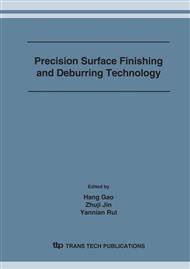p.279
p.283
p.289
p.295
p.303
p.309
p.315
p.321
p.325
Prediction of Surface Roughness Using Regression and ANN Models in High-Speed Finish Milling Operation
Abstract:
In this paper, multi-linear regression and artificial neural network (ANN) models have been developed to predict surface roughness in high-speed milling of 7050-T7451 aluminum alloy. Surface roughness is taken as the response variable, while cutting speed, feed per tooth, radial depth of cut and slenderness ratio are taken as independent input parameters. An orthogonal experiment design is developed to conduct experiments. The measured values of surface roughness are used to find the regression coefficients and train the neural network for prediction of surface roughness. Predicted values of surface roughness by both models are compared with the measured values.
Info:
Periodical:
Pages:
303-308
Citation:
Online since:
September 2007
Authors:
Price:
Сopyright:
© 2007 Trans Tech Publications Ltd. All Rights Reserved
Share:
Citation:


